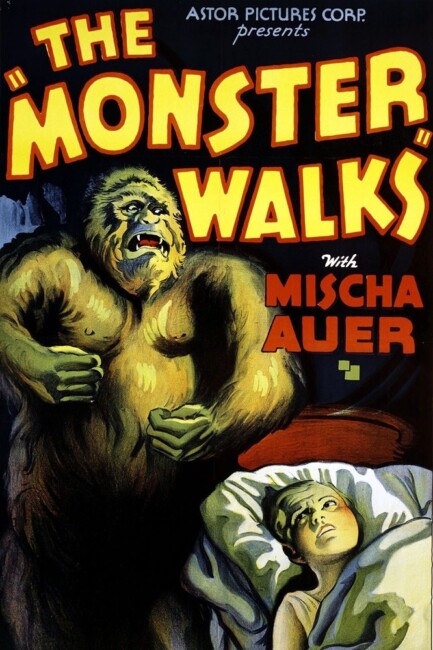
Rating:
★★
USA. 1932.
Crew
Director – Frank Strayer, Story/Adaptation – Robert Ellis, Photography (b&w) – Jules Cronjager. Production Company – Commonwealth Pictures Corp..
Cast
Rex Lease (Dr Ted Clayton), Vera Reynolds (Ruth Earlton), Sheldon Lewis (Robert Earlton), Mischa Auer (Hanns Krug), Martha Mattox (Emma Krug), Sidney Bracy (Herbert Wilkes), Sleep N’ Eat [Willie Best] (Exodus)
Plot
Following the death of Philip Earlton, his daughter Ruth arrives at his mansion for the reading of the will, accompanied her fiancé Dr Ted Clayton. Everything is left to Ruth, while Philip’s wheelchair-ridden brother Robert and Philip’s servants the Krugs are given a stipend and allowed to stay on. It is a dark a stormy night and so everybody prepares to settle in at the house for the night. As Ruth goes to bed, a hideous arm reaches through the wall to attack her. They cannot be sure if Yogi, the ape caged in Philip’s laboratory in the basement, has escaped or it is someone trying to kill Ruth to get the inheritance.
The so-called Golden Age of Horror began in 1931 and lasted until 1939 (or arguably some point into the 1940s). What kicked it off was the twin releases of Universal’s Dracula (1931) and Frankenstein (1931). A host of other horror films quickly followed. The Monster Walks was an effort made by Commonwealth Pictures Corp, one of the few independent studios back in the day that sought to jump aboard this bandwagon. This seems evident in the title The Monster Walks, which seems clearly intended to suggest something of Frankenstein even though there is no monster in the film apart of a fairly non-threatening if agitated chimpanzee kept in a cage in the basement laboratory.
In actuality, The Monster Walks belongs to an earlier type of horror film that predated the Golden Age of Horror – the Old Dark House Thriller. This began on stage in the 1910s and appeared in various film adaptations of the 1920s, in particular hits like The Bat (1926) and The Cat and the Canary (1927). The film relies on all the familiar tropes and plot elements from the Old Dark House film – it being a dark and stormy night outside; eyes peering out from the eyeholes portraits; hidden doors; secrets of the family members. It was customary in these films to feature a criminal with the name of an animal. This has no criminal but there is the ape in the basement laboratory, a trope that became a fixture of a number of later entries in the genre.
The plot set-up has been taken from The Cat and the Canary – of a group of relatives gathered at a mansion for the reading of the will with everything being left to a young heiress and assorted attempts then made to kill her and the others in line over the course of the night. The film is such a blatant copy of The Cat and the Canary that it even borrows the iconic shot of the arm of the killer sneaking out of a sliding panel above the sleeping heroine’s head, as well as features one of that film’s actors Martha Mattox.
Both The Bat and The Cat and the Canary are among some of the most stylishly directed of all American silent films. By contrast, The Monster Walks feels cheaply made. Frank Stayer’s directorial set-ups are crude and perfunctory at best – they feel like little more than the camera being pointed at a scene and the action taking place with little to no effort to generate atmosphere or suspense. There is also no musical score (this being made very early into the era of the sound film).
Everything reigns in at a brief 63 minutes. The denouement comes as a disappointingly flat unveiling of the killer’s identity, mainly due to the fact that because the film has limited cast line-up, there are not a lot of suspects to choose from especially after several of them start to get killed off. Among these, Willie Best, appearing under the name Sleep N’ Eat, plays what today is an astonishingly racist caricature of a dim-witted comic-relief chauffeur.
Director Frank Strayer made a number of other genre outings during this era, including The Vampire Bat (1933); another Old Dark House film The Ghost Walks (1934); the mad scientist film Condemned to Live (1935); and Death from a Distance (1936), a murder mystery with an SF twist. Most of these are cheap B programmers. Strayer is best known for the series of Blondie films made during the late 1930s/40s based on the popular syndicated comic-strip. Screenwriter Robert Ellis was a former actor who was also married to the film’s lead actress Vera Reynolds. Ellis later went on to write seven of 20th Century Fox’s Charlie Chan films.
Trailer here


